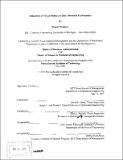| dc.contributor.advisor | David E. Hardt and Roy E. Welsch. | en_US |
| dc.contributor.author | Wolbert, Daniel (Daniel Joseph) | en_US |
| dc.contributor.other | Leaders for Manufacturing Program. | en_US |
| dc.date.accessioned | 2007-12-07T16:07:25Z | |
| dc.date.available | 2007-12-07T16:07:25Z | |
| dc.date.copyright | 2007 | en_US |
| dc.date.issued | 2007 | en_US |
| dc.identifier.uri | http://hdl.handle.net/1721.1/39689 | |
| dc.description | Thesis (M.B.A.)--Massachusetts Institute of Technology, Sloan School of Management; and, (S.M.)--Massachusetts Institute of Technology, Dept. of Mechanical Engineering; in conjunction with the Leaders for Manufacturing Program at MIT, 2007. | en_US |
| dc.description | Includes bibliographical references. | en_US |
| dc.description.abstract | In recent years the American industrial landscape has undergone tremendous change as companies have worked to adopt Lean practices. This transformation has been difficult, but necessary, as American companies work to remain competitive with foreign competitors. A key enabler of these Lean transformations has been the use of visual metrics to communicate how a process has performed as well as to set goals for future performance. The challenge is to first identify what data is available and then create metrics that encourage and reward Lean behaviors. This thesis explores the introduction of visual metrics for a part inspection process at the Raytheon Company. Prior to the introduction of these metrics, there was limited ability to determine how the process was performing. As a result, downstream customers were able to track when a part entered the inspection process but were unable to predict when the inspection would be completed. This introduced a risk to the process and created a sense of frustration through the facility. The visual metrics for the inspection area were created on a series of visual dashboards that display common Lean metrics, such as cycle time and backlog (or work-in-process). Through these dashboards the area will be able to understand how it is performing and initiate continuous improvement projects to improve performance. | en_US |
| dc.description.statementofresponsibility | by Daniel Wolbert. | en_US |
| dc.format.extent | 60 p. | en_US |
| dc.language.iso | eng | en_US |
| dc.publisher | Massachusetts Institute of Technology | en_US |
| dc.rights | M.I.T. theses are protected by copyright. They may be viewed from this source for any purpose, but reproduction or distribution in any format is prohibited without written permission. See provided URL for inquiries about permission. | en_US |
| dc.rights.uri | http://dspace.mit.edu/handle/1721.1/7582 | |
| dc.subject | Sloan School of Management. | en_US |
| dc.subject | Mechanical Engineering. | en_US |
| dc.subject | Leaders for Manufacturing Program. | en_US |
| dc.title | Utilization of visual metrics to drive intended performance | en_US |
| dc.type | Thesis | en_US |
| dc.description.degree | S.M. | en_US |
| dc.description.degree | M.B.A. | en_US |
| dc.contributor.department | Leaders for Manufacturing Program at MIT | en_US |
| dc.contributor.department | Massachusetts Institute of Technology. Department of Mechanical Engineering | |
| dc.contributor.department | Sloan School of Management | |
| dc.identifier.oclc | 175305525 | en_US |
